Story: Paul Guillien – Photos: Mathias Wolpert
There are few people that have made as big of an impact on the adventure mororcycle scene as Charley Boorman. The TV series he created with Ewan McGregor, some 20 years ago, did as much to put the obscure niche of adventure motorcycle travel into the mainstream consciousness as anything. Their tales of riding around the world on BMW R1150GSA motorcycles, in their show Long Way Round, were a huge success, having been watched by millions of viewers. They followed that up with additional TV series’ under the Long Way title, including the current iteration called Long Way Home, where the two ride motorcycles from McGregor’s home in Scotland to Boorman’s home in England, by way of a 10,000-mile loop through Scandinavia and up into the Arctic Circle, before venturing south into Eastern and Central Europe. (This 10-show series will be available on Apple TV).
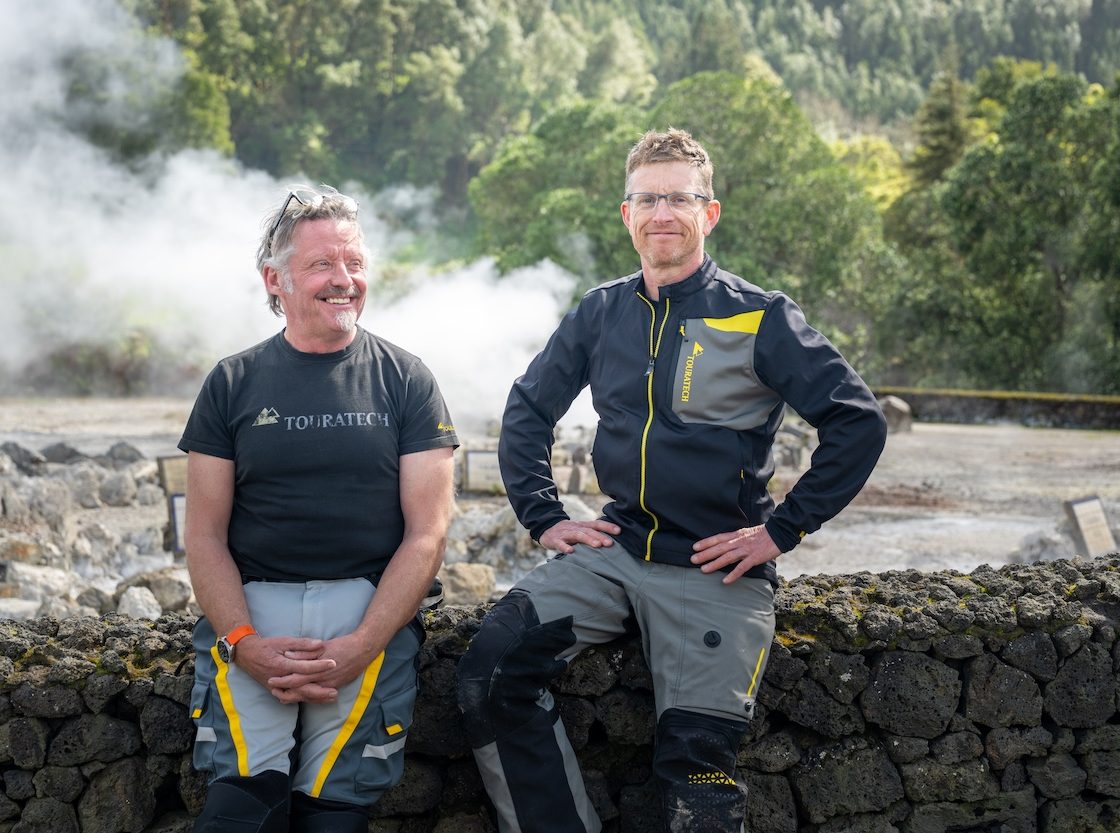
As I spend time getting to know Charley, he recalls being inspired by the Touratech catalogs in the early 2000’s. Inspiration that fueled his dreams of motorcycle adventure. It was not surprising that he and Ewan ended up partnering with Touratech for luggage and protection solutions for their BMW’s during their first Long Way TV show a few years later.
While nothing I’ve done can compare to the global impact that Charlie and Ewan’s TV shows have made, or had the effect that the Touratech catalog and subsequent, films and Travel Time magazines have made, I do feel good about my own efforts at Touratech-USA. For a decade and a half, we have built the Touratech Rally into the largest gathering of adventure motorcycles in the US. It features incredible riding, knowledge-sharing, and moto-centric entertainment. I’m also proud to have co-founded Backcountry Discovery Routes (BDR), which has made a big impact on inspiring people to ride adventure motorcycles in the vast public wildlands of America.
This year, BDR celebrates its 15-year anniversary. In that time, the non-profit organization has created 18 documentary films of route expeditions. With a staff of 4 employees, 9-person volunteer board and some 40 ambassadors, the organization currently provides the community with 20,000 miles curated adventure riding tracks that are available for free. The organization also offers planning resources on RideBDR.com and vigorously advocates for the interest of adventure riders.
So, it was a dream come true when Touratech brought me and Charley together to explore the Azores by motorcycles. Although, I have met Charley briefly at motorcycle shows over the years, as thousands of people have, he didn’t really know me. I also didn’t really know him other than from his TV shows that I have enjoyed over the years.
It’s completely surreal, a near out-of-body experience, when I first hear his voice crackle to life in my headset. It sounds so familiar, a voice I have heard hundreds of times over the last 20 years watching his TV shows, but in this moment, it was reality for me. We are just chatting away as I followed him on narrow urban streets leaving the city of Ponta Delgada, headed toward the North Coast. I feel like I’m Ewan, having a chat with Charley, in the headsets as we ride our BMWs to discover a new place for the first time. Never in my wildest dreams did I expect to be on a real-life adventure with Charley Boorman.

They call it the ‘Hawaii of Europe’, but in reality, it’s more temperate than Hawaii with an average high temperature ranging from the low 60’s in winter to the high 70’s in the summer. It does have similar precipitation and a lush green landscape reminiscent of Hawaii. Also, no shortage of wind!
We are early in the season, taking this trip in the second week of March, which mother nature reminds us, can be on the cold side. Fortunately for us, we are also doing a photo shoot for the new Touratech riding gear which are perfectly suited for a wild ride with unpredictable and extreme weather. Charlie is wearing the Companero World 2 suit, and I am wearing the Companero Rambler 2. Both feature multiple layers for cold weather which we experienced with temperatures as low a 4-degrees celsius (39 degrees Fahrenheit). We also stay dry with our waterproof Gore-Tex Pro Shell outer layers in the deluge of rain that douses us every day. The heavily armored suits featuring CE level 2 protection would prove to keep us both safe as we hit the ground when the challenging terrain and extreme weather exceeded our riding talent on a few occasions.
The roads are a perfect combination of twisty lanes through breathtaking lush green landscapes punctuated by blue sea and foaming white waves crashing into black volcanic rock formations. Away from the coast, we slip onto remote dirt and two-track lanes which wind endlessly through forest preserves and towering mountain-top lookouts. Saõ Miguel is an active volcano, and the terrain is a direct result of that. The black and reddish gravel is of volcanic origin and typically provides confidence-inspiring traction. However, in places, the gravel has large stones, the size of golf balls, which are a hazard to keeping the front wheel under the bike. Charley’s R1300GSA loses an argument with a set of marble-like stones and low-sides in a corner. The crashbars do their job and we are able to keep riding.

The island also features smooth dirt tracks that are comprised of volcanic ash which is fun to ride until it gets wet. When a squall comes out of nowhere, which it often does here, the smooth dirt turns to slippery clay in an instant. It feels like riding on a greased pan. I was caught out by a shallow rut that I never even saw. My front tire begins to wash out, then my back tire hits the same slippery rut and slides out to the left, putting me on a collision course with a rock wall. My F900GS and helmet come to an abrupt stop against black volcanic rock. My Aventuro Carbon Pro helmet keeps me safe. I am not injured, but I have broken the tower that supports the windscreen and instrument cluster. We get out the CruzTOOLS RoadTech kit and use the zip ties and mechanic’s to wire to stabilize the loose tower before continuing the ride.
We are treated to iconic views as we ride the rugged dirt road that follows a ridge circumnavigating Sete Cidades, the most famous caldera on the island. To our right, we see breathtaking views of the Atlantic Ocean with its stormy white-cap waves and wind-driven foam. To our left is an impossibly-steep slope that has short green vegetation with a corrugated texture that almost looks like that of a ruffles potato chip. At the bottom of the green wall are the emerald waters of Lagoa Azul (Blue Lake) and Lagoa Verde (Green Lake). This is the place you see on the travel web sites and we can understand why. It’s a dramatic landscape that is breathtaking to experience in person. This caldera is the result of land collapsing into a void left by a retired magna chamber from a past volcanic cycle. There are several on the island and this one is magnificent because of its vast size and being perfectly framed by the ocean on 3 sides as it takes up nearly the entire west end of the island.
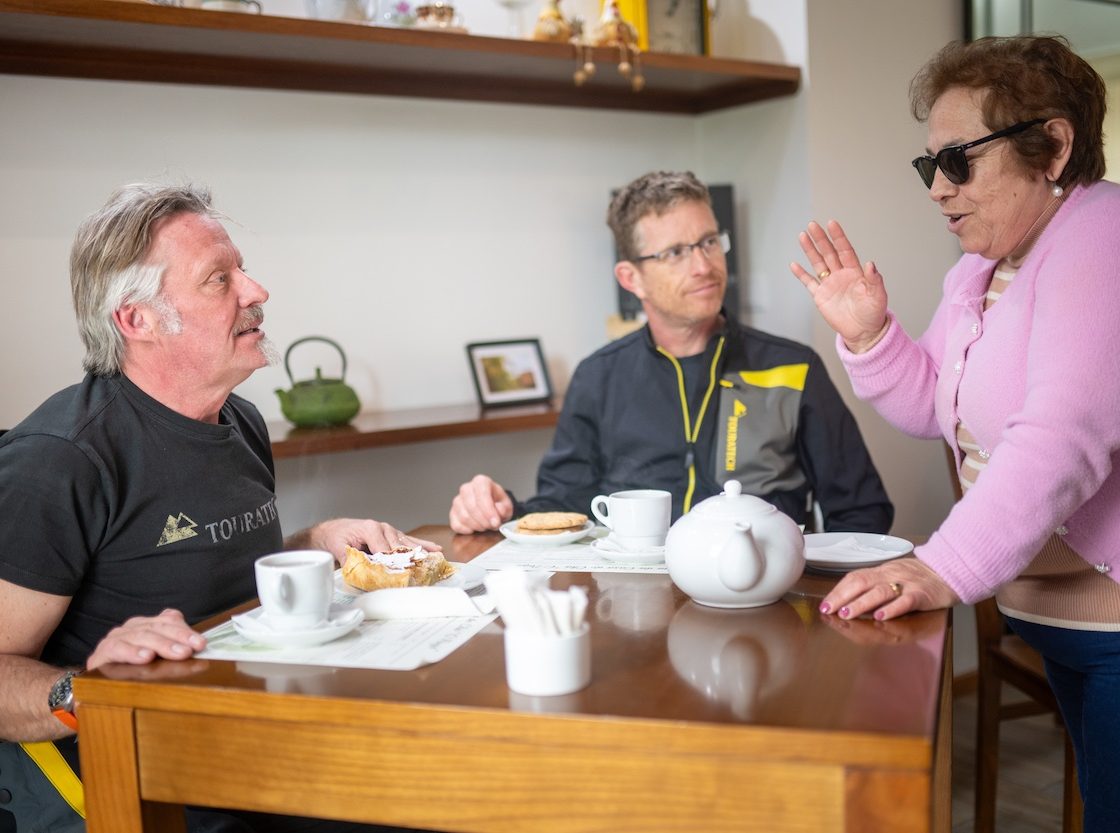
We meet with a local geologist who has been studying the volcanos of the Azores for nearly 40 years. As we stand with him, high on a look-out at Pico do Ferro, he points out several calderas as he explains how the landscapes and geothermal features have been formed by volcanic activity over the years. He explains that the earthquake we woke up to the other morning was a 5.2 in magnitude and located about 30 kilometers from where we are standing. Earthquakes are taken very seriously here because of past tragedies, the most notable of which, occurred in the year 1522, when an earthquake and resulting mudslide buried and killed an estimated 5,000 residents. We part ways on an ominous note, as the geologist reminds us that this place is an active volcano that could erupt at any time.
Saõ Miguel features scores of sleepy sea-side villages with clusters of buildings constructed with white walls and terracotta roofs. As we roll through them, we can just sense the calm. Time seems to stand still here. Island life at its finest. The locals are laid back and have a gentle vibe. Much like the dairy cows they care for. Even in the capital city of Ponta Delgada things feel mellow. The people we interact with are pleasant and friendly. It feels very safe and welcoming. The most distinguishing of palates will be delighted with the culinary gifts of the Azores. With a very active fishery, the seafood is as fresh as it gets, the cheese is award winning, and the 500-year tradition of the Azores native Ramo Grande beef, are a highlight of our dining experience.
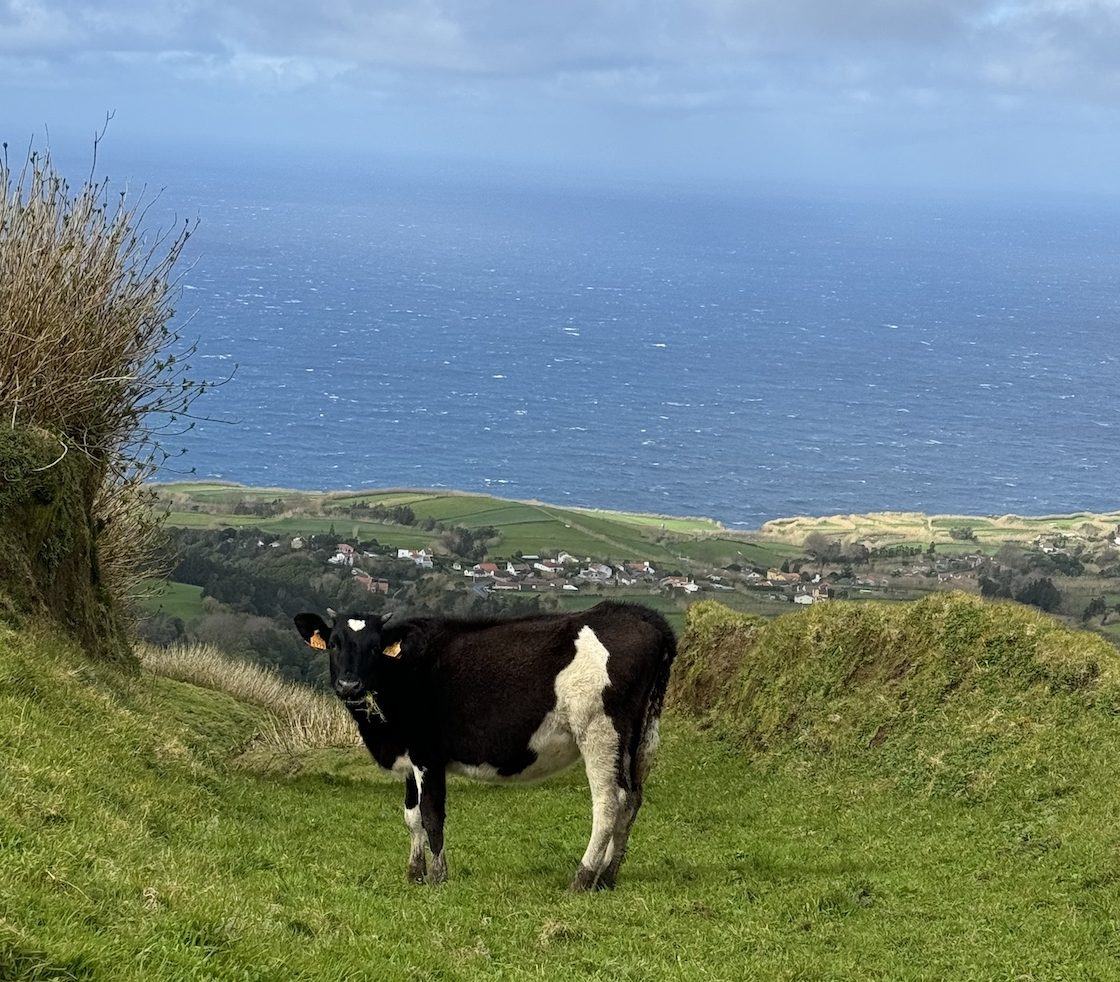
We see more dairy cows than people as we explore the island. Outside of the main city of Ponta Delgada, most men are wearing knee-high rubber boots. A clear indication that they work in the wet and muddy pastures of a dairy farm. Most of the farms are small family-owned operations with 20 to 100 Holstien-Friesian dairy cows. We don’t see large barns because most of the milking is done with mobile machines which allow the cows stay out in the fields. The cows are almost entirely pasture fed which is not standard in most parts of the world. The quality of life for the cows is considered quite good by dairy farming standards. Grazing pastures make up approximately 40% of Saõ Miguel by area. We see stunning seaside plots of land with million-dollar views, where a person might ordinarily expect to see luxury homes or golf courses in another part of the world. Here, the most gorgeous ocean-view landscapes are not for the rich and famous. They are reserved for the black-and-white-spotted dairy cows. These gentle giants live in idyllic cow paradise and are the heart and soul of Saõ Miguel.
The Island is completely exposed to the ferocity of the Atlantic Ocean, and this week a storm is raging. We ride through intermittent rain showers driven by gale-force winds. The island has many incredible vantage points which they call miradouros. We battle the wind as we ride a narrow dirt two-track road up to the miradoura at Pico da Cruz. We park the bikes and stagger toward the windward edge. Standing on the precipice, with our arms out, we lean into the wind while the gusts support the weight of our bodies. We lean forward at nearly 45-degree angles to the ground floating on the wind like a base jumper with a squirrel suit. Upon return to our bikes, we are shocked to see they have been blown flat to the ground. A short time later, I ride around a corner to find another motorcyclist in distress. He’s waiving furiously to get my attention as he lays on the ground with his bike. I squat down, grab the rear wheel with both hands, and lift the back of his bike up to release his right leg that was pinned under the swing arm. He tells me that he was blown over by a wind gust and has been laying there, trapped, for several minutes. This place is wild!
While I expected warm weather and more sunshine, the reality ended up being much cooler. A few of the summit lookouts had temperatures of 40 degrees with piercing wind. Then 30 minutes later we’d be eating lunch in the sunshine in a quaint seaside village shedding our layers and enjoying the pleasant weather. Charley jokes about how we’ve experienced 4 seasons in the same hour in the Azores. Although we didn’t get the typical mild weather, we did get to fully experience the power of the Atlantic Ocean and see the wild side of the Azores. We felt alive out there and have stories that we’ll not soon forget. As for riding with Charley, he is exactly the same guy in-person that he is on tv. I enjoyed his quick wit, British humor, and zest for exploring on 2-wheels.
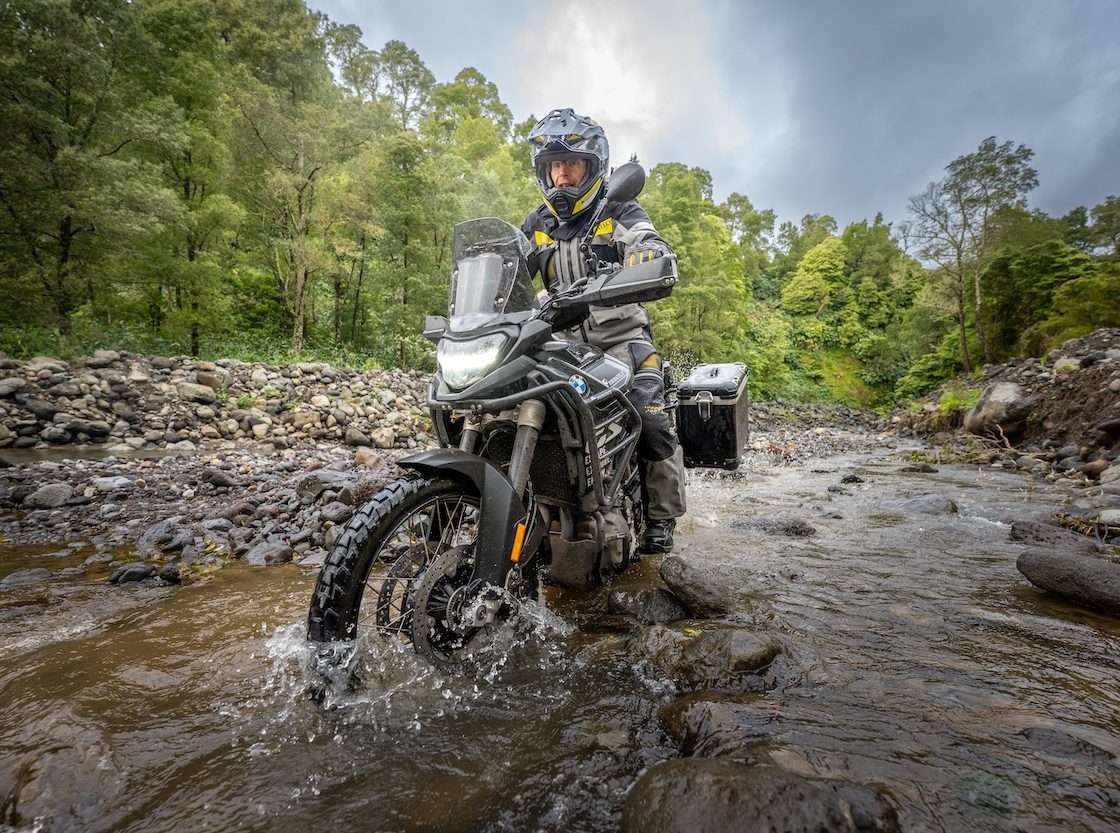
General Information:
Often referred to as the ‘Hawaii of Europe’ the Azores are a 9-island archipelago in the middle of the Atlantic Ocean, which are an autonomous territory of Portugal. Located 870 miles west of Lisbon and about 1,200 miles southeast of Newfoundland, the climate of the islands is mild year-round. Daytime high temperatures normally fluctuate between 16° and 25°C (61° and 77°F) depending on season. The main industries are agriculture, dairy farming, livestock, fishing, and tourism. The islands have volcanic origins and are located at the intersection of three of the world’s major tectonic plates. The islands boast dramatic coastal landscapes as well as stunning geological wonders, many of which continue to be active volcanos. The vegetation is lush and green with weather that tends to be wet and cloudy. When the sun does emerge from the clouds, the colors of the island and its waters are breathtaking.
Getting there:
Major European cities like London, Paris, Frankfurt, Barcelona, and Amsterdam offer direct flights to Azores. From the USA, direct flights are available from Boston, New York, and Oakland. While each island does have an airport for inter-island travel the only ones that connect to the outside world are João Paulo II (on São Miguel Island), followed by Lajes Airport (Terceira Island) and Horta Airport (Faial Island). Seasonal ferry service runs between some of the islands but not all. We stayed on Saõ Miguel for our adventure.
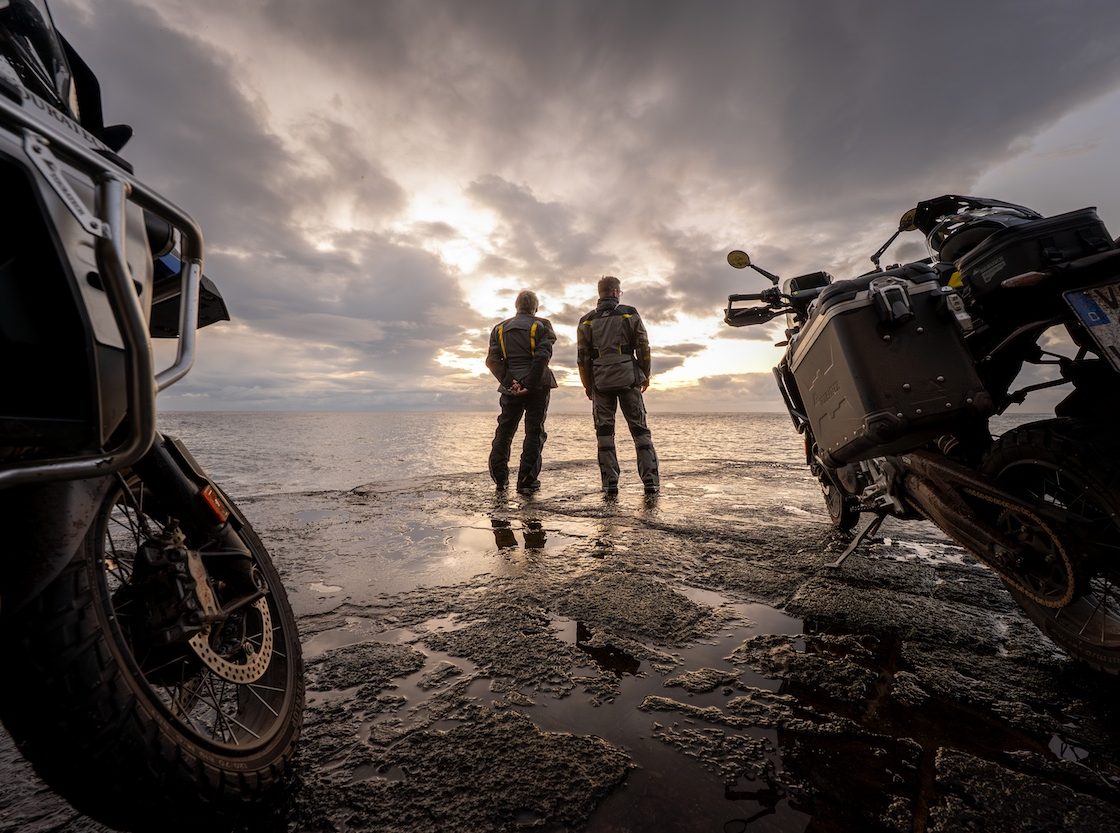
Getting around:
Both cars and motorcycles are available for rent on Saõ Miguel. Personal motorcycles can be shipped to the Saõ Miguel with freight forwarders. Touratech Portugal organizes ADV Rallye events on the island which include both accommodations and bike shipping (from Lisbon) in addition to organized rides, and incredible island cuisine.
Life on the Islands:
You will be hard pressed to find a place with seafood that is more fresh and delectable. Bounty of the sea dominates most restaurant menus here. The thriving dairy industry produces award winning cheese and incredible steaks from the native Ramo Grande cattle lineage which is a delicacy. The region is also known for producing pineapple, orange, banana, taro, and sweet potato. Bars, restaurants, and coffee shops are plentiful. The locals tend to be quiet and seem accepting of visitors.
You can see the Azores Untamed Film in its entirety here.
Are you planning an adventure on two wheels? Whether it’s a weekend trip with friends or a ride through the Azores, Touratech USA has all of the accessories, luggage and gear you need.